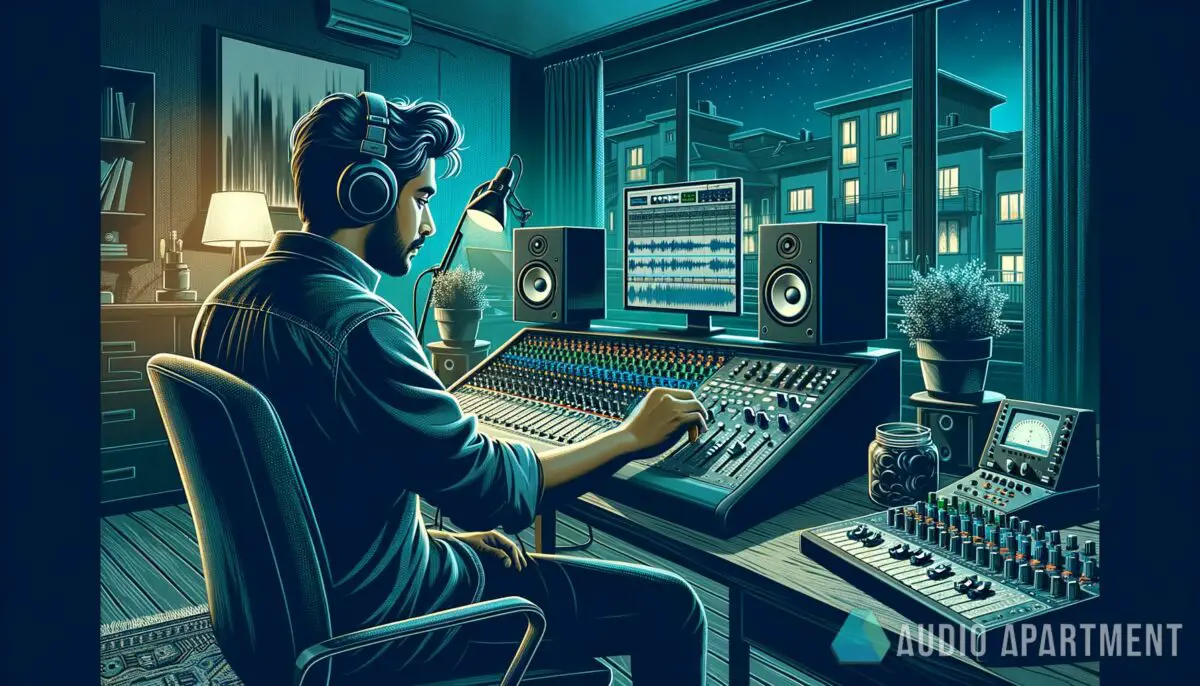Man, in my home studio, it’s like every knob tweak is a leap of faith. But, choosing between the best studio monitors and headphones can be as fiery as a debate over analog versus digital.
Seriously, how can you craft the perfect bass tone? We’re diving into the tight grooves of mixing that thumping low end.
If you are a visual learner, check out this video titled ‘6 Bass Tone Fixes (Beginners, Stop Sounding Like a Newb)’
Get the lowdown on bass mastery right here.
Key takeaways
- Choose the right bass sound to fit your track’s genre and feel.
- Use EQ and compression wisely for clarity and consistency.
- Reference your mix on various systems to ensure even playback.
- Practice patience and persistence to finesse your bass tone.
How to craft the perfect bass tone in your mixes
Getting your bass to sit right in the mix is like being behind the bar, mixing the ingredients for the ultimate cocktail – it’s all about balance, flavor, and knowing your tools. To lay down a bass line that’s both full-bodied and clear, we’ll break down the essentials, step by step, so even the newest audio mixologists can serve up some killer low-end vibes.

Step 1: Choose the right bass sound
Selecting the bass sound that fits your track is crucial. Whether you’re recording a live bass or programming a sampled one, the sound must complement the genre and feel of your track.
Think of it as the base spirit of your cocktail – it sets the direction for everything that follows.
Step 2: Dial in the EQ
With your bass sound selected, it’s time to tweak the EQ settings. Cut out any low-end rumble below 40Hz to clean up the mix and carve out space around 100-200Hz to let the bass punch through.

EQ is your sound seasoning, so sprinkle it with care to enhance the taste without overpowering the mix.
Step 3: Apply compression
Now, let’s get that dynamic range smoothed out with some compression. Set your attack time to let some initial transients through and a release time that grooves with the tempo.
Compression binds the flavors of your bass just right – too much, and you’ll flatline the vibe; too little, and it won’t hold together.
Step 4: Add some saturation
To give your bass tone warmth and presence, add a touch of saturation. This is like aging your mix in a wooden cask; it adds character and depth to the sound.
But remember, a little goes a long way – you’re aiming for a fine vintage, not an overcooked mess.

Step 5: Play with stereo width
While bass is typically centered in the mix, a slight stereo spread can add dimension. Use this technique sparingly; it’s the garnish that can bring out that extra oomph in the track.
You’ll want your bass to fill the room but not take over the dance floor.
Step 6: Reference your mix
Lastly, it’s all about the taste test. Check your mix on different systems – from headphones to monitors to ensure your bass translates well everywhere.
Imagine serving your cocktail at different bars; it needs to hit the same quality notes no matter where it’s enjoyed.
AKAI Professional MPK Mini MK3

AKAI Professional MPK Mini MK3
More crafting the perfect bass tone tips
Now that we’ve got the fundamentals down, let’s amp up your mix with some extra flair. These tips are the secret sauce, the cherry on top that can elevate your bass from groovy to straight-up legendary.
- Experiment with layering different bass sounds to create depth.
- Use sidechain compression to make the bass pump with the kick drum.
- Automate EQ and effects to make the bass line more dynamic.
- Keep an eye on your levels; the bass shouldn’t overpower other elements.
- Record multiple takes and comp the best parts for optimal performance.
When it comes to dos and don’ts, consider this your cheat sheet to keep your bass tones tight and just right.
| Do | Don’t |
|---|---|
| Use a high-pass filter on other tracks to leave room for the bass. | Overdo effects that can muddy the bass sound. |
| Reference your mix on various systems to ensure consistency. | Neglect the balance between bass and kick drum. |
| Maintain phase coherence when recording multiple bass tracks. | Ignore the harmonic content of your bass sound. |
| Use a tuner to ensure your bass is perfectly in tune. | Let your bass peak and cause distortion unexpectedly. |
Advantages and disadvantages of crafting the perfect bass tone
Honing the bass tone is critical in music production as it can make or break a track. While the process is creative and rewarding, it’s not without its challenges.
Advantages
- A well-crafted bass provides a solid foundation for the entire mix.
- It can enhance the groove and rhythm of your track, making it more compelling.
- A perfect bass tone can translate well across various playback systems.
- It contributes to the emotional impact and energy of the music.
Disadvantages
- Achieving the right tone can be time-consuming and require patience.
- Balancing the bass volume with other mix elements can be tricky.
- Without proper treatment, the bass can muddy other frequencies.
- It might necessitate advanced plugins or gear that are cost-prohibitive for some home studios.
“Getting your bass to sit right in the mix is crucial—it’s all about balance, flavor, and knowing your tools. Use compression to bind the flavors of your bass just right – too much, and you’ll flatline the vibe; too little, and it won’t hold together.”
In my humble opinion, and I’m no Quincy Jones, but I think crafting the perfect bass tone is part art, part science. You’ve gotta feel the vibe of the track and let that guide your every move.
I’ve noticed that when the bass is dialed in tight, everything else just falls into place – it’s like the heartbeat of the track. Yeah, it can be a bit intimidating at first, especially when you’re not looking to invest in a heap of pro gear.
But hey, even with some basic equipment and a lot of trial and error, you can still get your bass sounding lit. Check out the essential audio mixing techniques for home studios for some foundational tips to get started.
And here’s the real talk: It’s all about patience and persistence. My first few mixes?
Let’s just say they needed some major CPR on the bass. But I didn’t let that curve stop me.
I kept tweaking, learning, and, yeah, facing facts when something didn’t slap. Now?
I feel solid about dropping that bass like it’s hot, even though I’m an amateur. But, you know what?
That growth feels as good as dropping the needle on a fresh vinyl. Dig in, do your homework, and you’ll be stoked at how far you can come with just passion and some helpful guidance, like finding out what role digital signal processors play in audio production.
Frequently asked questions (FAQ)
What’s the best way to ensure my bass tone works in all playback systems?
Ensuring your bass tone works across all systems starts with frequent referencing. Switch between different listening environments like studio monitors, car speakers, and headphones to compare how your bass translates.
This cross-referencing can help you make adjustments to ensure consistency.
Can I fix a weak bass tone during mastering?
Yes, to some extent. Mastering can enhance a weak bass tone using tools like multiband compression or EQ.
However, it’s better to address any tonal issues during the mixing phase. Mastering should be the polish on an already solid mix, not a rescue mission.
Should the bass always be mono?
In most cases, keeping the bass mono ensures a solid foundation, as stereo effects can cause phase issues in club environments. But occasionally, slight stereo enhancement on the higher frequencies of the bass sound can add an interesting dimension without compromising stability.
Final thoughts
Wrapping up, remember that laying down the perfect bass tone is a blend of technical prowess and creative instinct – like the mixology of sound. Have a blast with it, experiment, and trust your ears.
With a solid beat and a bass that vibes just right, you’re well on your way to making mixes that resonate with the soul and get feet tapping.
Hey, so how confident are you feeling about getting that bass to sit just right in your next mix? Did I cover everything you wanted to know? Let me know in the comments section belowI read and reply to every comment.
If you found this article helpful, share it with a friend and check out my full blog for more tips and tricks on crafting the perfect bass tone. Thanks for reading and keep those low frequencies grooving!















